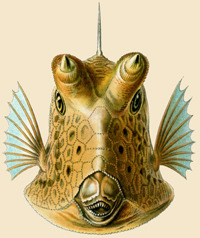Model Specimen
• A good specimen
• A valuable specimen
• Different ways of looking
• Different storage needs
• Seeing from afar
______________________________
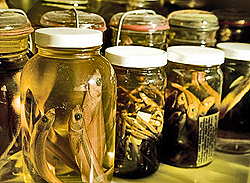
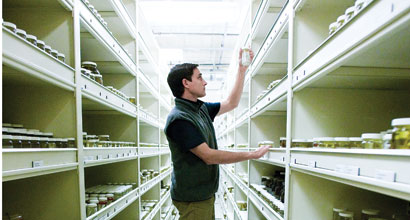
Do these fish look fresh? Although death, chemistry and light cause color to rapidly fade , these fish are well-preserved. These fish are stored in solutions of either formalin or alcohol and arranged on shelves by family name. Photographer - Marc Tule.
More about chemical preservatives
Materials safety data sheet (MSDS) - formalin
Materials safety data sheet (MSDS) - isopropyl alcohol
Recommendations from the Burke Museum at the University of Washington.
What makes a good scientific specimen for collections? Generally - one that isn't a duplicate and one that preserves as much of the character of the living specimen as possible. The specimen should also be preserved in a way that allows particular kinds of analysis. Scientific specimens also need reliable information about where and when a specimen was collected.
Starting with a high-quality specimen is paramount. You can take a great photo of a damaged or exceptional fish but you often want a great photo of a undamaged and typical fish. A fish that's missing parts or one that's less than fresh isn't ideal unless it's so rare that it's the only one anyone has ever seen.
Specimen preservation is equally important. You can start with a fresh fish, but if it's not stored properly, it's going to be a very decomposed fish very soon. With careful preservation, many fishes in the collections at Scripps are decades to nearly a century old. However, a single preservation doesn't serve all purposes equally well. What's preserved ideally for eating, by freezing for example, may not leave a specimen in good shape for viewing under a microscope. Certain preservatives might keep the fish intact for microscope observation but destroy it's DNA. So there's an art and science to keeping specimens in good shape.
Why choose that individual? But getting back to more basics, out of all the living animals from which we should choose our specimen, why this one over that? There are all sorts of considerations ranging from any one will do because they are so hard to catch, a small one because we have no way to carry back a big one to the lab, to ... Sometimes you just want an average one so you don't want it to be particulary diseased, ... or ... Other times you want one with a a particular affliction. Sometimes one specimen will do but other times, they look different at different life stages so you want one at each life stage, or there is great variety in a species like dogs, so you need to capture the natural variation in species.
There is usually a special specimen called a "holotype" kept at some museum or collection in the world for each kind of named animal. The holotype is the
Aquaria samples ...
Specimen selection is an important part of the process although we'll leave it at that.
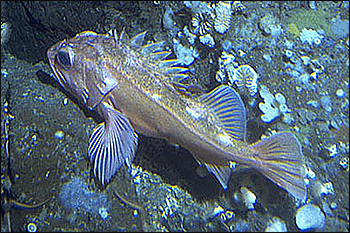
A valuable specimen
Text goes here.
The special case of the type specimen
Type specimens Genus and species.Type specimens.
Official description of a new or renamed species.
The official rules

Type specimen
Different ways of looking at specimens
If three days is too long for fresh fish, how do you keep a fish around for 100 years and more?
Specimens can be stored dry or wet, but the fishes in scientific collections are usually preserved in liquid preservatives such as solutions of isopropanol and formalin. Samples shrivel much less stored in wet solutions and they remain pliable enough for dissection.
Formalin is ... Since formalin is a carcinogen, it poses greater health hazards than alcohol. However, some features such as ... Cindy? are better preserved. Storage facilities such as those at Scripps have excellent air circulation to prevent the accumulation of ... vapors.
As observational technologies change, just one method of preservation may not work for all kinds of analyses. For example, freezing works for DNA analysis because it doesn't destroy DNA molucules. But regular freezing destroys cellular structures as water expands as it freezes. Formalin preservation destrys DNA but preserves cellular structures.
As we learn more about MRI imaging on stored samples and specimens that aren's human, we're learning about how to produce better quality images ...
Preserving color
Regardless of the preservative, the vibrant colors of fish aren't preserved. Like most other things colored with organic dyes, like the fabric in your sofa or a poster, fishes fade in sunlight so collections are usually windowless. Instead of turning lighter, the fishes in a collection appear to be shelves-upon-shelves of jars filled with brown fishes in brownish-yellow liquid. Fish ... content lose their color the fastsest because ...
Some fishes lose their color long before they arrive at collections. One of the brightest f
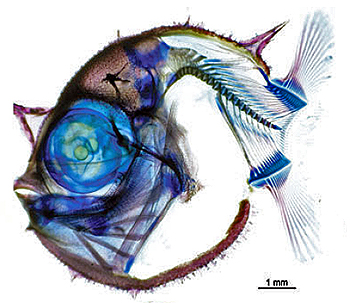
Storing specimens
If three days is too long for fresh fish, how do you keep a fish around for 100 years and more?
Specimens can be stored dry or wet, but the fishes in scientific collections are usually preserved in liquid preservatives such as solutions of isopropanol and formalin. Samples shrivel much less stored in wet solutions and they remain pliable enough for dissection.
Formalin is ... Since formalin is a carcinogen, it poses greater health hazards than alcohol. However, some features such as ... Cindy? are better preserved. Storage facilities such as those at Scripps have excellent air circulation to prevent the accumulation of ... vapors.
As observational technologies change, just one method of preservation may not work for all kinds of analyses. For example, freezing works for DNA analysis because it doesn't destroy DNA molucules. But regular freezing destroys cellular structures as water expands as it freezes. Formalin preservation destrys DNA but preserves cellular structures.
As we learn more about MRI imaging on stored samples and specimens that aren's human, we're learning about how to produce better quality images ...
Preserving color
Regardless of the preservative, the vibrant colors of fish aren't preserved. Like most other things colored with organic dyes, like the fabric in your sofa or a poster, fishes fade in sunlight so collections are usually windowless. Instead of turning lighter, the fishes in a collection appear to be shelves-upon-shelves of jars filled with brown fishes in brownish-yellow liquid. Fish ... content lose their color the fastsest because ...
Some fishes lose their color long before they arrive at collections. One of the brightest f
 Home
Home
